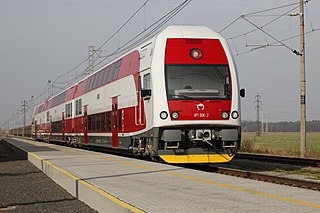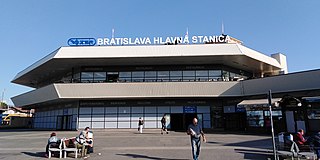This article needs additional citations for verification .(September 2014) (Learn how and when to remove this template message) |
Slovak rail border crossings, as of 2007. Crossings in italic are abandoned. Year of opening in brackets.
This article needs additional citations for verification .(September 2014) (Learn how and when to remove this template message) |
Slovak rail border crossings, as of 2007. Crossings in italic are abandoned. Year of opening in brackets.
Note that all those railway lines were built before dissolution of Czechoslovakia in 1993 and became border in that year

Transport in Slovakia is possible by rail, road, air or rivers. Slovakia is a developed Central European country with a well-developed rail network (3,662 km) and a highway system (225.25 km). Main international airport is the M. R. Štefánik Airport in the capital, Bratislava. Most important waterway is the river Danube used both by passenger, cargo and freight ships.

In rail transport, track gauge or track gage is the spacing of the rails on a railway track and is measured between the inner faces of the load-bearing rails.

The Norwegian railway system comprises 4,087 km of 1,435 mm track of which 2,622 km is electrified and 242 km double track. There are 696 tunnels and 2,760 bridges.

A dual gauge railway is a track that allows the passage of trains of two different track gauges. It is sometimes called a "mixed gauge" track. A dual gauge track consists of three rails. There will be two vital rails, one for each gauge close together and a third rail, a "common" rail further away. Sometimes, four rails are required using two outer and two inner rails to create the dual gauge. Dual gauge is not to be confused with a "third rail" or "check or guard rails".

Petržalka is the largest borough of Bratislava, the capital of Slovakia. Situated on the right bank of the river Danube, the area shares a land border with Austria, and is home to around 100,000 people.

With railways, a break of gauge occurs where a line of one gauge meets a line of a different gauge: specifically a different track gauge. Trains and rolling stock cannot run through without some form of conversion between gauges, and freight and passengers must otherwise be transshipped. A break of gauge adds delays, cost, and inconvenience.

Railways of the Slovak Republic is the state-owned railway infrastructure company of Slovakia.
These are all the Czech rail border crossings as of 2007. Crossings in italics are abandoned. The year of opening is in brackets.

Bratislava hlavná stanica is the major railway station in Bratislava, Slovakia. It is located near Šancová Street, around 1 km or a 15 min walk north from the historical part of the Old Town.

Rail transport in the Netherlands uses a dense railway network which connects nearly all major towns and cities. There are as many train stations as there are municipalities in the Netherlands. The network totals 3,223 route km on 6,830 kilometres of track; a line may run both ways, or two lines may run on major routes. Three-quarters of the lines have been electrified.
Polish rail border crossings as of 2007, abolished cross-border lines are in italic. Year of opening in brackets.

Rail transport in Slovakia began on 21 September 1840, with the opening of the first horse-powered line from Bratislava to Svätý Jur. The first steam-powered line, from Bratislava to Vienna, opened on 20 August 1848.

Štrba railway station is a break-of-gauge junction station serving the village of Štrba, in the Prešov Region, northeastern Slovakia.

Bratislava Lamač railway station is a small railway station inside the Lamač borough of Bratislava, Slovakia. Until 1947 the station was called "Lamač". The railway station is administered under Bratislava hlavná stanica, with the station master residing there as well. It lies at the edge of the Lamač and Dúbravka boroughs of Bratislava.

The Oberhausen–Arnhem railway is a two-track, electrified main line railway running close to the lower Rhine from Oberhausen via Wesel, Emmerich and the German–Dutch border to Arnhem and forms part of the line between the Ruhr and Amsterdam. The line was opened by the Cologne-Minden Railway Company in 1856 and is one of the oldest lines in Germany.

Kysak railway station serves the village and municipality of Kysak, in the Košice Region, eastern Slovakia. Opened in 1870, the station is an important railway junction, where the Košice–Plaveč–Čirč–Muszyna railway diverges towards Poland from the Košice–Žilina railway, which is part of Slovakia's main east-west rail corridor.

Spišská Nová Ves railway station serves the town and municipality of Spišská Nová Ves, in the Košice Region, eastern Slovakia.
The Vejprty–Annaberg-Buchholz railway is a branch line in the Czech Republic and the German state of Saxony. The line extends the Chomutov–Vejprty/Reitzenhain railway at Vejprty (Weipert), crossing the Czech-German border and running via Cranzahl to Annaberg-Buchholz. It has been operated since 2001 by Erzgebirgsbahn, which is part of DB Regio.

Čierna nad Tisou railway station is an important border railway station in the town of Čierna nad Tisou, Košice Region, Slovakia. It is close to the border with Ukraine and, as the railways have two different gauges, all trains have to change gauge here: the railway has 916 tracks and is the biggest 'harbour on land' in Central Europe. The first station across the border is Chop. The station is on the Pan-European Corridor VA from Venice in Italy to Kiev in Ukraine via Bratislava, Žilina, Košice and Uzhhorod.
These are all Hungarian rail border crossings as of 2016. Crossings in bold have passenger traffic. Crossings in italics are abandoned. The year of opening is in brackets.